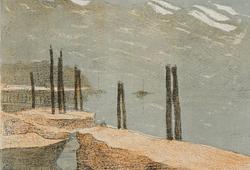Martin Wickström
"Stranded"
Signed Martin Wickström and dated 2005 on verso. Oil on canvas with assemblage 88 x 200 cm.
Provenance
Lars Bohman Gallery, Stockholm.
Exhibitions
Eskilstuna konstmuseum, "Anita och havet", 23 August - 12 October 2008.
Literature
"99_09 Martin Wickström", 2009, illustrated spread p. 316-317.
More information
Ahead of Martin Wickström’s last exhibition ‘Paradiso (Out of the Red)’, that took place during the winter of 2018, Galerie Forsblom described his work brilliantly:
“From the breath-taking play of light across building facades to dizzying mountain passes, Martin Wickström combines paintings, models and ready-mades in intricate installations into presentations ranging from a personal family album to the international political arena. In Wickström’s work, psychoanalysis and semiotics meet in an interaction between the documentary and private life. Previously existing cultural material – documentary photographs, portraits of film stars from days gone by, or fragments from a Spiderman cartoon – mingle with personal experiences and elements from recent history. Everything is skilfully combined in a balancing act between pop art and Swedish melancholy. Something seductive emerges from Wickström’s process: in the colouring, highlights and brushwork. At times the shimmering sediment of the enchanting painting is shattered by sawed off and white-painted shapes, brutally screwed to the surface of the painting – a silhouette of a residential complex or a simple office chair. The sign occupies the foreground, though its information is greatly reduced. Meanwhile, these components demand to be anchored in a room other than the one depicted. The perspective shifts from signs to motifs, from mass culture to melancholy.”





























